计算机导论-第5章 软件工程
- 格式:ppt
- 大小:1.97 MB
- 文档页数:52
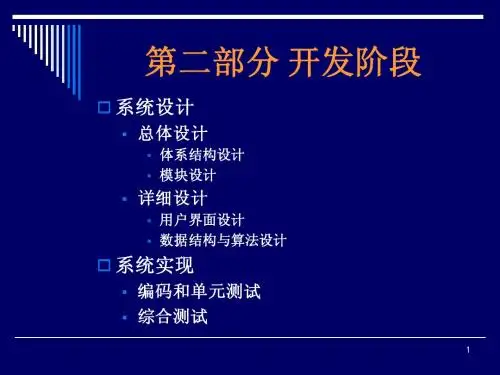
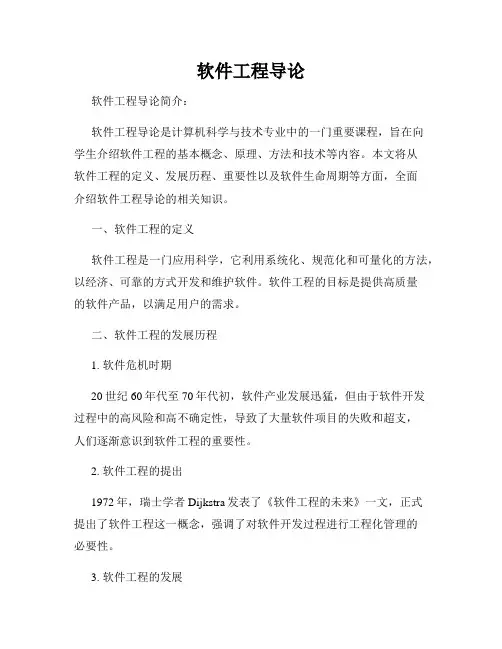
软件工程导论软件工程导论简介:软件工程导论是计算机科学与技术专业中的一门重要课程,旨在向学生介绍软件工程的基本概念、原理、方法和技术等内容。
本文将从软件工程的定义、发展历程、重要性以及软件生命周期等方面,全面介绍软件工程导论的相关知识。
一、软件工程的定义软件工程是一门应用科学,它利用系统化、规范化和可量化的方法,以经济、可靠的方式开发和维护软件。
软件工程的目标是提供高质量的软件产品,以满足用户的需求。
二、软件工程的发展历程1. 软件危机时期20世纪60年代至70年代初,软件产业发展迅猛,但由于软件开发过程中的高风险和高不确定性,导致了大量软件项目的失败和超支,人们逐渐意识到软件工程的重要性。
2. 软件工程的提出1972年,瑞士学者Dijkstra发表了《软件工程的未来》一文,正式提出了软件工程这一概念,强调了对软件开发过程进行工程化管理的必要性。
3. 软件工程的发展随后,软件工程逐渐成为一个独立的学科,并在学术界和工业界得到了广泛的应用和推广。
软件工程的理论和方法也日益完善,其中包括需求分析、软件设计、编码、测试等一系列开发过程中的关键技术。
三、软件工程的重要性1. 提高软件质量软件工程以系统化和规范化的方式进行软件开发,通过严格的质量控制和测试,大大提高了软件产品的质量,降低了软件缺陷和故障的发生率。
2. 提高开发效率软件工程引入了各种开发工具和方法,帮助开发人员提高开发效率,减少重复劳动,提高工作效能。
3. 减少开发成本通过软件工程的管理方法和技术手段,能够有效控制软件开发过程中的风险和成本,及时发现和处理问题,从而降低开发成本。
四、软件生命周期1. 需求分析阶段需求分析是软件开发过程中的第一步,旨在确定用户的需求和期望,并将其转化为形式化的需求规格。
2. 设计阶段设计阶段依据需求分析的结果,将软件系统划分为模块,并确定各个模块的功能和接口。
3. 编码阶段在编码阶段,开发人员根据设计文档编写源代码,并进行单元测试和集成测试。
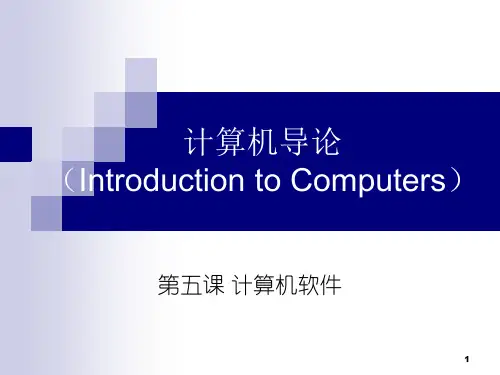
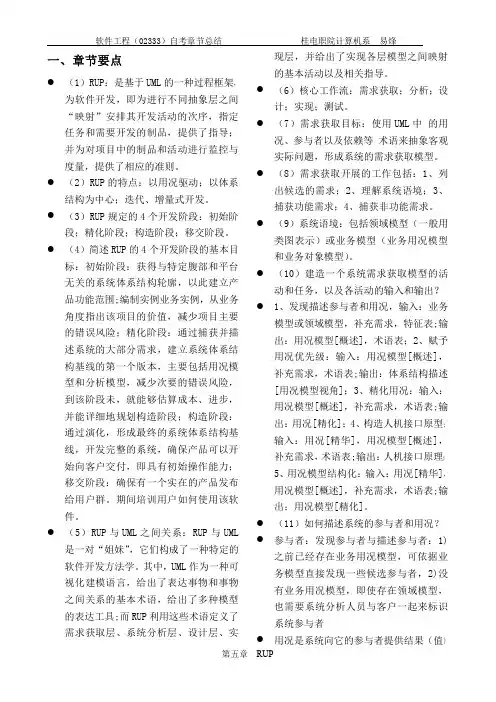

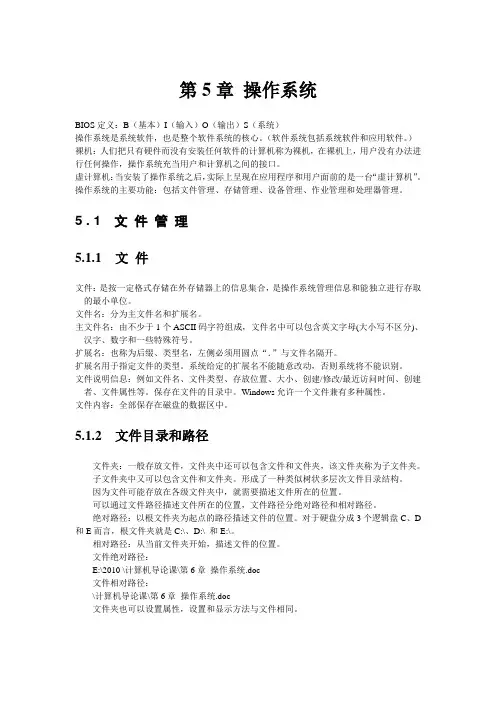
第5章操作系统BIOS定义:B(基本)I(输入)O(输出)S(系统)操作系统是系统软件,也是整个软件系统的核心。
(软件系统包括系统软件和应用软件。
)裸机:人们把只有硬件而没有安装任何软件的计算机称为裸机,在裸机上,用户没有办法进行任何操作,操作系统充当用户和计算机之间的接口。
虚计算机:当安装了操作系统之后,实际上呈现在应用程序和用户面前的是一台“虚计算机”。
操作系统的主要功能:包括文件管理、存储管理、设备管理、作业管理和处理器管理。
5 . 1 文件管理5.1.1 文件文件:是按一定格式存储在外存储器上的信息集合,是操作系统管理信息和能独立进行存取的最小单位。
文件名:分为主文件名和扩展名。
主文件名:由不少于1个ASCII码字符组成,文件名中可以包含英文字母(大小写不区分)、汉字、数字和一些特殊符号。
扩展名:也称为后缀、类型名,左侧必须用圆点“.”与文件名隔开。
扩展名用于指定文件的类型。
系统给定的扩展名不能随意改动,否则系统将不能识别。
文件说明信息:例如文件名、文件类型、存放位置、大小、创建/修改/最近访问时间、创建者、文件属性等。
保存在文件的目录中。
Windows允许一个文件兼有多种属性。
文件内容:全部保存在磁盘的数据区中。
5.1.2 文件目录和路径文件夹:一般存放文件,文件夹中还可以包含文件和文件夹,该文件夹称为子文件夹。
子文件夹中又可以包含文件和文件夹。
形成了一种类似树状多层次文件目录结构。
因为文件可能存放在各级文件夹中,就需要描述文件所在的位置。
可以通过文件路径描述文件所在的位置,文件路径分绝对路径和相对路径。
绝对路径:以根文件夹为起点的路径描述文件的位置。
对于硬盘分成3个逻辑盘C、D 和E而言,根文件夹就是C:\、D:\ 和E:\。
相对路径:从当前文件夹开始,描述文件的位置。
文件绝对路径:E:\2010 \计算机导论课\第6章操作系统.doc文件相对路径:\计算机导论课\第6章操作系统.doc文件夹也可以设置属性,设置和显示方法与文件相同。

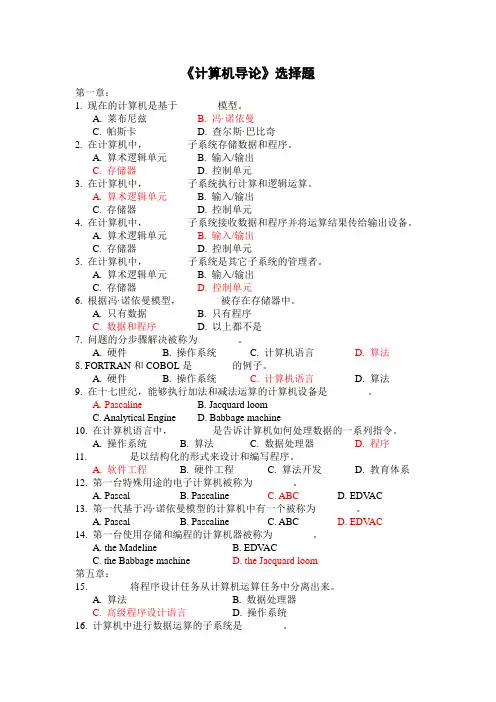
《计算机导论》选择题第一章:1. 现在的计算机是基于________模型。
A. 莱布尼兹B. 冯·诺依曼C. 帕斯卡D. 查尔斯·巴比奇2. 在计算机中,________子系统存储数据和程序。
A. 算术逻辑单元B. 输入/输出C. 存储器D. 控制单元3. 在计算机中,________子系统执行计算和逻辑运算。
A. 算术逻辑单元B. 输入/输出C. 存储器D. 控制单元4. 在计算机中,________子系统接收数据和程序并将运算结果传给输出设备。
A. 算术逻辑单元B. 输入/输出C. 存储器D. 控制单元5. 在计算机中,________子系统是其它子系统的管理者。
A. 算术逻辑单元B. 输入/输出C. 存储器D. 控制单元6. 根据冯·诺依曼模型,________被存在存储器中。
A. 只有数据B. 只有程序C. 数据和程序D. 以上都不是7. 问题的分步骤解决被称为________。
A. 硬件B. 操作系统C. 计算机语言D. 算法8. FORTRAN和COBOL是________的例子。
A. 硬件B. 操作系统C. 计算机语言D. 算法9. 在十七世纪,能够执行加法和减法运算的计算机设备是________。
A. PascalineB. Jacquard loomC. Analytical EngineD. Babbage machine10. 在计算机语言中,________是告诉计算机如何处理数据的一系列指令。
A. 操作系统B. 算法C. 数据处理器D. 程序11. ________是以结构化的形式来设计和编写程序。
A. 软件工程B. 硬件工程C. 算法开发D. 教育体系12. 第一台特殊用途的电子计算机被称为________。
A. PascalB. PascalineC. ABCD. EDV AC13. 第一代基于冯·诺依曼模型的计算机中有一个被称为________。


软件工程导论第五章课后答案本页仅作为文档页封面,使用时可以删除This document is for reference only-rar21year.March第五章习题答案1、为每种类型的模块耦合举一个具体例子。
答:耦合是对一个软件结构内不同模块之间互连程度的度量。
耦合强弱取决于模块间接口的复杂程度,进入或访问某一模块的点,以及通过接口的数据,一般模块之间可能的连接方式有7种,构成耦合的7种类型,它们之间的关系为:下面举例说明以上各种耦合:a.非直接耦合(Nondirect Coupling)在这种情况下,两个模块之间没有直接关系,它们之间的联系完全是通过主模块的控制和调用来实现的,这就是非直接耦合。
例如在实数的运算中,有两个模块分别完成几个实数的求和,求乘积功能,这两个模块之间没有直接联系,只有在主模块调用中有执行的前后顺序而已,这个例子即属于非直接耦合。
b.数据耦合(DataCoupling)即一个模块访问另一个模块时,彼此之间是通过数据参数来交换输入,输出信息的,这种耦合为数据输入,输出信息的这种耦合为数据耦合。
如有两个模块,其中A完成两个烽的比较,求出其中最大的并返回该值,模块B是完成了个数的比较,求出其中最大的并返回该最大值,为完成四个数的比较,模块B调用模块A即可完成,在这种调用关系中,模块A的运算结果作为一个参烽参加B的运算,这两个模块之间即发生数据耦合。
数据耦合是松散的耦合,模块间的独立性比较强。
c.标记耦合(Stamp Coupling),即一组模块通过参数传递记录信息,这就是标记耦合。
事实上,这组模块共享了这个记录,它是某一数据结构的子结构,而不是简单变量。
d.控制耦合(Control Coupling)即一个模块通过开关标志,名字等控制住处明显的控制,选择另一模块的功能,这就是控制耦合,如下图所示,这一种耦合实质是在单一接口上实现选择多功能模块中的某项功能,如程序设计中用到多路选择结构即是最好的例子。
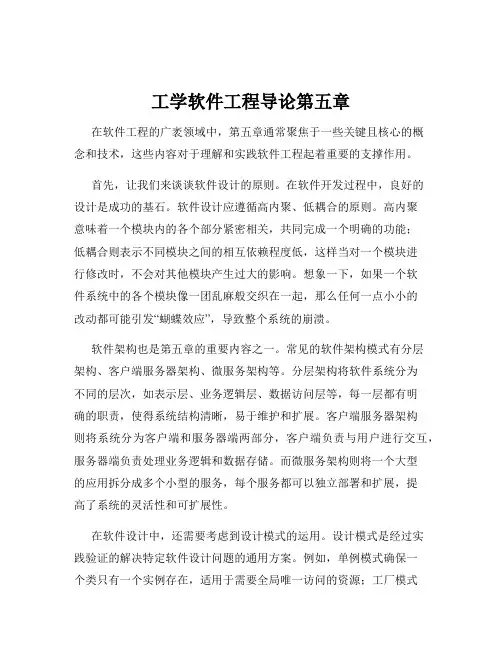
工学软件工程导论第五章在软件工程的广袤领域中,第五章通常聚焦于一些关键且核心的概念和技术,这些内容对于理解和实践软件工程起着重要的支撑作用。
首先,让我们来谈谈软件设计的原则。
在软件开发过程中,良好的设计是成功的基石。
软件设计应遵循高内聚、低耦合的原则。
高内聚意味着一个模块内的各个部分紧密相关,共同完成一个明确的功能;低耦合则表示不同模块之间的相互依赖程度低,这样当对一个模块进行修改时,不会对其他模块产生过大的影响。
想象一下,如果一个软件系统中的各个模块像一团乱麻般交织在一起,那么任何一点小小的改动都可能引发“蝴蝶效应”,导致整个系统的崩溃。
软件架构也是第五章的重要内容之一。
常见的软件架构模式有分层架构、客户端服务器架构、微服务架构等。
分层架构将软件系统分为不同的层次,如表示层、业务逻辑层、数据访问层等,每一层都有明确的职责,使得系统结构清晰,易于维护和扩展。
客户端服务器架构则将系统分为客户端和服务器端两部分,客户端负责与用户进行交互,服务器端负责处理业务逻辑和数据存储。
而微服务架构则将一个大型的应用拆分成多个小型的服务,每个服务都可以独立部署和扩展,提高了系统的灵活性和可扩展性。
在软件设计中,还需要考虑到设计模式的运用。
设计模式是经过实践验证的解决特定软件设计问题的通用方案。
例如,单例模式确保一个类只有一个实例存在,适用于需要全局唯一访问的资源;工厂模式用于创建对象,将对象的创建与使用分离,提高了代码的灵活性和可维护性;观察者模式实现了对象之间的一对多依赖关系,当一个对象的状态发生改变时,所有依赖它的对象都会得到通知并自动更新。
另外,软件的接口设计也不容忽视。
一个好的接口应该具有简洁、明确、稳定的特点。
简洁的接口易于理解和使用,明确的接口能够准确地传达其功能和参数要求,稳定的接口则保证在软件的后续开发和维护过程中不会频繁变动,从而避免对依赖它的其他部分造成影响。
在软件设计的过程中,还需要进行充分的需求分析。
工学软件工程导论第五章在软件工程的广袤领域中,第五章往往承载着关键的知识与理念,为我们进一步理解和实践软件工程奠定坚实的基础。
这一章,通常会聚焦于软件设计的核心原则与方法。
软件设计,就像是为一座即将拔地而起的高楼大厦绘制蓝图,其重要性不言而喻。
首先,我们来谈谈模块化设计。
将一个庞大而复杂的软件系统分解为若干个相对独立且具有特定功能的模块,每个模块专注于完成一项特定的任务。
这不仅使得软件的开发和维护变得更加容易,还提高了代码的可重用性。
想象一下,如果所有的代码都混在一起,就像一团乱麻,要找出问题或者进行修改,那简直是一场噩梦。
而通过模块化,我们可以清晰地知道每个模块的职责,当需要修改或优化某个功能时,只需关注对应的模块,大大提高了效率。
接口设计也是软件设计中的重要一环。
一个良好定义的接口,就像是一扇清晰的窗口,让不同的模块能够顺畅地交流和协作。
接口定义了模块之间的交互规则和数据传递方式,它应该简洁、清晰、稳定。
如果接口设计得不合理,模块之间的通信就会变得混乱,甚至导致整个系统的崩溃。
比如说,一个模块期望接收的数据格式与另一个模块提供的数据格式不一致,这就会引发严重的错误。
在软件设计中,还需要考虑架构模式的选择。
常见的架构模式有分层架构、客户端服务器架构、微服务架构等等。
每种架构模式都有其适用的场景和优缺点。
分层架构将系统分为不同的层次,每一层都有明确的职责,使得系统具有良好的层次结构和可扩展性。
客户端服务器架构则适用于需要将计算任务分布在不同的节点上的情况。
而微服务架构则将一个大型的应用拆分成多个小型的服务,每个服务都可以独立部署和扩展,提高了系统的灵活性和敏捷性。
另外,数据设计也是不能忽视的部分。
数据的组织、存储和访问方式直接影响着软件的性能和效率。
选择合适的数据结构和数据库管理系统,对于处理大量的数据至关重要。
比如,如果我们需要频繁地进行插入和删除操作,链表可能是一个更好的选择;而如果需要快速的查找,数组或者二叉搜索树可能更合适。
第1章计算机概述一、单项选择题A B D B C C D B A D二、简答题1. 根据计算机所采用的电子逻辑元件可将计算机的发展划分为4个发展阶段,每个阶段所采用的元器件分别为:电子管,晶体管,中、小规模集成电路,大规模、超大规模集成电路。
2. 冯·诺依曼计算机主要由4部分组成:运算器、存储器、控制器、输入/输出设备。
3. 衡量计算机性能的指标主要有5个,分别为:字长、主频、存储容量、运算速度和存取周期。
4. 计算机的特点:1)能自动连续、高速度地运算;2)运算速度快;3)运算精度高;4)具有超常的记忆能力;5)具有可靠的逻辑判断能力。
按运算规模,计算机可分为巨型机、大型机、中型机、小型机、微型机和工作站。
第2章计算机中的数据一、单项选择题A ABC B二、计算题1.(1)7 (2)511 (3)40762.(1)766O (2)201O (3)265O3.(1)251O (2)6272O (3)64361363O4.(1)0.1B (2)≈101.01B (3)110011B三、简答题1. 计算机采用二进制表示数据主要有以下4个原因:1)二进制物理上易于实现;2)二进制运算法则简单;3)二进制编码机器可靠性高;4)二进制通用性和逻辑性强。
2. 在计算机中,所有数值型数据都用二进制编码来表示,这串二进制编码称为该数据的机器数,数据原来的表现形式称为“真值”。
一个进制中数码的个数称为“基数”。
3. 带符号整数常用的编码形式有3种,分别为原码、反码和补码。
1)原码表示法为:最高位是符号位(0表示正,1表示负),其余各位表示数的绝对值大小。
2)反码表示法为:最高位是符号位(0表示正,1表示负),正数的反码与原码相同,负数的反码是在其原码的基础上,除符号位外各位求反。
3)补码表示法为:最高位是符号位(0表示正,1表示负),正数的补码与原码相同,负数的补码是在该数反码的最低位加1。
4. 要表示文本,必须先对每个可能出现的字符进行表示。
Chapter 5 Computer OrganizationKnowledge point:5.1. three subsystems that make up a computer5.2. functionality of each subsystem5.3. memory addressing and calculating the number of bytes5.4. addressing system for input/output devices.5.5. the systems used to connect different components together.Multiple-choice Questions39. The ___ is a computer subsystem that performs operations on data.( Knowledge point 5.1)a. CPUb. memoryc. I/O hardwared. none of the above40. ____ is a stand-alone storage location that holds data temporarily. ( Knowledge point 5.1)a. An ALUb. A registerc. A control unitd. A tape drive41. ____ is a unit that can add two inputs. ( Knowledge point 5.2)a. An ALUb. A registerc. A control unitd. A tape drive42. A register in a CPU can hold ____.( Knowledge point 5.2)a. datab. instructionsc. program counter valuesd.all of the above43. A control unit with five wires can define up to ____ operations. ( Knowledge point 5.2)a. 5b. 10c. 16d. 3244. A word is ____ bits. ( Knowledge point 5.3)a. 8b. 16c. 32d. any of the above45. If the memory address space is 16 MB and the word size is 8 bits, then ____ bits are needed to access each word. ( Knowledge point 5.3)a. 8b. 16c. 24d.3246. The data in ____ are erased if the computer is powered down. ( Knowledge point5.5.3)a. RAMb. ROMc. a tape drived. a CD-ROM47. ____ is a memory type with capacitors that need to be refreshed periodically. ( Knowledge point 5.3)a. SRAMb. DRAMc. ROMd. all of the above48. ____ is a memory type with traditional flip-flop gates to hold data. ( Knowledge point 5.3)a. SRAMb. DRAMc. ROMd. all of the above49. There are ____ bytes in 16 terabytes. ( Knowledge point 5.3)a.b.c.d.50. ____ can be programmed and erased using electronic impulses but can remain ina computer during erasure. ( Knowledge point 5.3)a. ROMb. PROMc. EPROMd. EEPROM51. ____ is a type of memory in which the user, not the manufacturer, storesprograms that cannot be overwritten. ( Knowledge point 5.3)a. ROMc. EPROMd. EEPROM52. CPU registers should have ____ speed memory. ( Knowledge point 5.3)a. highb. mediumc. lowd. any of the above53. Main memory in a computer usually consists of large amounts of ____ speedmemory. ( Knowledge point 5.3)a. highb. mediumc. lowd. any of the above54. The ____ memory contains a copy of a portion of main memory. ( Knowledge point 5.3)a. CPUb. cachec. maind. ROM55. The ____ is nonstorage I/O device. ( Knowledge point 5.4)a. keywordb. monitorc. printerd. all of the above56.A ____ is an optical storage device. ( Knowledge point 5.4)a. CD-ROMb. CD-Rc. CD-RMd. all of the above57. The ____ is a storage device in which the manufacturer writes information to the disc. ( Knowledge point 5.4)a. CD-ROMb. CD-Rc. CD-RMd. all of the above58. The ____ is a storage device in which the user can writes information only onceto the disc. ( Knowledge point 5.4)a. CD-ROMb. CD-Rc. CD-RMd. all of the above59. The ____ is a storage device that can undergo multiple writings and erasings. ( Knowledge point 5.4)b. CD-Rc. CD-RMd. all of the above60. The smallest storage area on a magnetic disk that can be accessed at one time isa ____.( Knowledge point 5.4)a. trackb. sectorc. framed. head61. For a magnetic disk, the ____ time is the time it takes for the read/write head tomove to the desired track where the data are stored. ( Knowledge point 5.4)a. rotationb. seekc. transferd. location62. Polycarbonate resin is used in ____ . ( Knowledge point 5.4)a. CD-ROMsb. CD-Rsc. CD-RWsd. all of the above63. In a ____, a high-power laser beam simulates pits in an alloy of silver, indium,antimony, and tellurium. ( Knowledge point 5.4)a. CD-ROMb. CD-Rc. CD-RMd. all of the above64. In a ____, a high-power laser beam simulates pits in the dye layer. ( Knowledge point 5.4)a. CD-ROMb. CD-Rc. CD-RMd. all of the above65. Which optical storage device has the highest capacity ? ( Knowledge point 5.4)a. CD-ROMb. CD-Rc. CD-RMd. DVD66. In a DVD, a ____ beam reads the disk. ( Knowledge point 5.4)a. high-power laserb. infraredc. red laserd. blue laser67. A ____ bus connects the CPU and memory. ( Knowledge point 5.5)a. datab. addressc. controld. all of the above68. If the word size is 2 bytes, a data bus with ____ wires is needed. ( Knowledge point 5.5)a. 2b. 4c. 8d. 1669. If the memory has words, the address bus needs to have ____ wires. ( Knowledge point 5.5)a. 8b. 16c. 32d. 6470. A control bus with eight wires can define ____ operations. ( Knowledge point 5.5)a. 8b. 16c. 256d. 51271. The ____ controller features a parallel interface and daisy-chained connection forI/O devices. ( Knowledge point 5.5)a. SCSIb. Fire Wirec. USBd. IDE72. The ____ controller is a serial device that connects slow devices such as thekeyboard and mouse to the computer. ( Knowledge point 5.5)a. SCSIb. Fire Wirec. USBd. IDE73. The ____ controller is a high-speed serial interface that transfers data in packets. ( Knowledge point 5.5)a. SCSIb. Fire Wirec. USBd. IDE74. The three steps in the running of a program on a computer are performed ____in this specific order. ( Knowledge point 5.5)a. fetch, execute, and decodeb. fetch, execute, and fetchc. fetch, decode, and executed. decode, fetch, and execute75. In the ____ method to synchronize the operation of the CPU with the I/Odevice ,the I/O device informs the CPU when it is ready for data transfer.( Knowledge point 5.5)a. programmed I/Ob. interrupt-driven I/Oc. DMAd. isolated I/O76. In the ____ method to synchronize the operation of the CPU with the I/O device,the CPU is idle until the I/O operation is finished. ( Knowledge point 5.5)a. programmed I/Ob. interrupt-driven I/Oc. DMAd. isolated I/O77. In the ____ method to synchronize the operation of the CPU with the I/O device,a large block of data can be passed from an I/O device to memory directly.( Knowledge point 5.5)a. programmed I/Ob. interrupt-driven I/Oc. DMAd. isolated I/OReview questions:1. What are the three subsystems that make up a computer?(Knowledge point 5.1) Answer: the CPU, main memory, and the input/output (I/O) subsystem.2. What are the parts of a CPU? (Knowledge point 5.1)Answer: The CPU performs operations on data and has a ALU, a control unit, and a set of registers.3. What‘s the function of the ALU? (Knowledge point 5.2)Answer: The ALU performs arithmetic and logical operations.Exercises:78. A computer has 64MB of memory. Each word is 4 bytes. How many bits are needed to address each single word in memory? (Knowledge point 5.3)Solution:The memory address space is 64 MB, that is 2 raised to the power 26. The size of each word in bytes is 2 raised to the power 2. So we need 24(subtract 2 from 26) bits to address each single word in memory.79. How many bytes of memory are needed to store a full screen of data if the screen is made of 24 lines with 80 characters in each line? The system uses ASCII code, witheach ASCII character store as a byte. (Knowledge point 5.3)Solution:The quantity of bytes in a full screen is 1920 (24*80) while the system uses ASCII code with each ASCII character store as a byte. So we need 1920 bytes of memory to store the full screen of data.80. An imaginary computer has four data registers(R0 to R3), 1024 words in memory, and 16 different instructions(add, subtract, etc.). What is the minimum size of an instruction in bits if a typical instruction uses the following format: add 565 R2. (Knowledge point 5.5)Solution:The number of data registers in this computer is 4, that is 2 raised to the power 2. The number of words in this computer is 1024, that is 2 raised to the power 10. The number of instructions in this computer is 16, that is 2 raised to the power 4. So the minimum size of an instruction in bits is 16 (2+10+4) bits.81. If the computer in Exercise 80 uses the same size of word for data and instructions. What is the size of each data register? (Knowledge point 5.5) Solution:The size of an instruction in bits is 16. Data size is the same with that of an instruction. So 16 is the size of each data register.82. What is the size of the instruction register of the computer in Exercise 80? (Knowledge point 5.5)Solution:The size of an instruction in bits is 16. So the size of the instruction register of the computer is also 16.83. What is the size of the program counter of the computer in Exercise 80? (Knowledge point 5.5)Solution:The number of words in this computer is 1024, that is 2 raised to the power 10. So the size of the program counter of the computer is 10.84. What is the size of the data bus in Exercise 80? (Knowledge point 5.5) Solution:Data size of this computer in bits is 16. So the size of the data bus is 16.85. What is the size of the address bus in Exercise 80? (Knowledge point 5.5) Solution:The number of words in this computer is 1024, that is 2 raised to the power 10. So the the size of the address bus is 10.86. What is the minimum size of the control bus in Exercise 80? (Knowledge point5.5)Solution:There are 2 control actions(read and write to memory) at most. So the minimum size of the control bus is 1.87. A computer uses isolated I/O addressing. Memory has 1024 words. If each controller has 16 registers, how many controllers can be accessed by this computer? (Knowledge point 5.4)Solution:Memory has 1024 words. So the address space is 1024. Each controller has 16 registers. Then we get 64 (divide 16 by 1024)controllers which can be accessed by this computer.88. A computer uses memory-mapped I/O addressing. The address bus uses 10 lines. If memory is made of 1000 words, how many four-register controllers can be accessed by this computer? (Knowledge point 5.4)Solution:The address bus uses 10 lines. So, the address space is 1024(2 raised to the power 10). The memory is made of 1000 words and each controller has four registers. Then we get (1024-1000)/4 = 6 four-register controllers which can be accessed by this computer.。
第五章总体设计低耦合(5 种类型)1. 数据耦合:数据传递2.控制耦合:控制信息传递3.特征耦合:传过多的信息给被调用模块4.公共环境耦合:因全局变量,共享通信区5.内容耦合:诸如一个模块访问另一个模块内部z高内聚(7 种类型)功能内聚10 分顺序内聚9分通信内聚7分过程内聚 5 分时间内聚3分逻辑内聚 1 分偶然内聚0 分z面向数据流的设计方法划分出组成系统的物理元素——程序、文件、数据库、人工过程和文档等等设计软件的结构。
也就是要确定系统中每个程序是由哪些模块组成的,以及这些模块相互间的关系。
总体设计过程两个阶段1.系统设计阶段,确定系统的具体实现方案;2.结构设计阶段,确定软件结构。
总体设计过程9个步骤1 设想供选择的方案2 选取合理的方案3 推荐最佳方案4 功能分解5 设计软件结构 6 设计数据库7 制定测试计划 8 书写文档 9 审查和审核划分出组成系统的物理元素——程序、文件、数据库、人工过程和文档等等设计软件的结构。
也就是要确定系统中每个程序是由哪些模块组成的,以及这些模块相互间的关系。
总体设计过程两个阶段1.系统设计阶段,确定系统的具体实现方案;2.结构设计阶段,确定软件结构。
总体设计过程9个步骤1 设想供选择的方案2 选取合理的方案3 推荐最佳方案4 功能分解5 设计软件结构 6 设计数据库7 制定测试计划 8 书写文档 9 审查和审核1.欲开发一个银行的活期存取款业务的处理系统:储户将填好的存/取款单和存折交给银行工作人员,然后由系统作以下处理;(1)业务分类处理:系统首先根据储户所填的存/取款单,确定本次业务的性质,并将存/取款单和存折交下一步处理;(2)存款处理:系统将存款单上的存款金额分别记录在存折和帐目文件中,并将现金存入现金库;最后将存折还给储户;(3)取款处理:系统将取款单上的取款金额分别记录在存折和帐目文件中,并从现金库提取现金;最后将现金和存折还给储户。
绘制该系统的数据流图和软件结构图。
计算机科学导论3到5章第三章介绍了计算机系统的基本结构和组成。
计算机系统由硬件和软件组成,硬件包括中央处理器(CPU)、内存、输入设备和输出设备,而软件则包括操作系统和应用程序。
本章还介绍了计算机底层的基本概念,如位、字节、数据表示和存储,以及计算机的工作原理和执行指令的过程。
第四章讨论了编程语言的基本概念和特点。
编程语言可分为低级语言和高级语言。
低级语言如汇编语言和机器语言,直接操作计算机硬件;而高级语言如C、Java和Python,则提供了更高级的抽象和更方便的编程方式。
本章还介绍了编译器和解释器的工作原理,以及程序的编译和执行过程。
第五章探讨了算法的概念和应用。
算法是解决问题的一系列步骤和规则,它是计算机科学的核心概念之一、本章介绍了算法的基本特性,如输入、输出、确定性和有穷性。
此外,还介绍了常见的算法设计技术,如递归、分治法和动态规划。
本章还介绍了算法分析的方法和复杂度理论,用来衡量算法的效率和时间复杂度。
在计算机科学导论的这几章中,我们学习了计算机系统的基本结构和组成、编程语言的基本概念和特点,以及算法的基本原理和设计技术。
这些知识是理解计算机科学的基础,并为进一步学习计算机科学的各个领域打下了坚实的基础。
此外,这些章节还可以帮助我们了解计算机科学的历史发展和未来趋势,从而对计算机科学的发展和应用有更深入的了解。
总之,计算机科学导论的第三到第五章涵盖了计算机科学的核心概念和理论基础,包括计算机系统的工作原理、编程语言和算法的基本知识。
通过学习这些章节,我们可以对计算机科学有一个全面的了解,并为进一步深入学习计算机科学的各个领域打下基础。